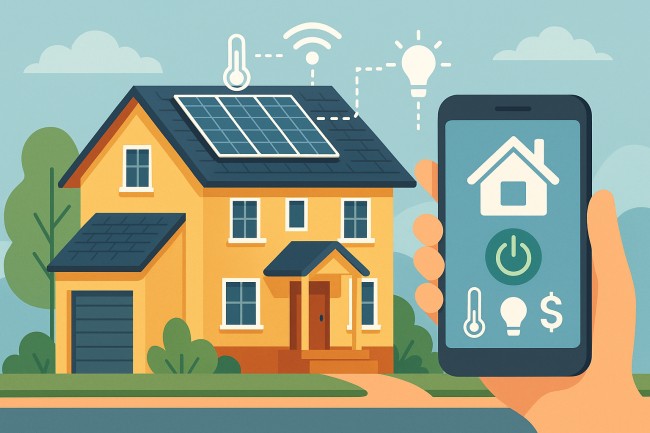
That monthly energy bill – most of us just accept it as a fixed cost of modern living. But what if your house could actually work to reduce that number?
The new wave of smart home technology isn’t about flashy gadgets; it’s about practical systems that automatically optimize your energy use, putting real money back in your pocket without sacrificing comfort.
The key is knowing where to look first. In most homes, the heating and cooling system is the biggest energy consumer, often accounting for nearly half of the utility bill. Water heating comes next, followed by those sneaky “phantom loads” – the energy your electronics devour even when they’re supposedly off.
Giving Your Home a Brain: The Smart Thermostat
If you only make one upgrade, this should be it. Replacing a basic thermostat with a smart model is like giving your home’s climate control system a brain transplant. Traditional programmable thermostats simply follow a schedule, oblivious to whether you’re home, away, or on vacation.
A smart thermostat, however, learns your life. Models like Ecobee or Nest figure out your family’s patterns within days. They automatically lower the heat after you’ve left for work, and can gently adjust the temperature overnight when you’re tucked under blankets.
The real game-changer is the remote control via smartphone. Stuck in traffic? Delay the heating cycle with a quick tap. Returning home early from a trip? Tell your house to have everything comfortable by the time you arrive.
The result? Most users see a 10-15% reduction in their annual heating and cooling costs – often paying for the device in a single season.
Lighting That Thinks for Itself
The humble light bulb has undergone a quiet revolution. While switching to LEDs is essential (they use a fraction of the energy and can last for decades), the real magic happens when you make them smart.
This isn’t just about changing colors with your voice. Imagine your outdoor lights turning on automatically at dusk and off at dawn, whether you’re home or not.
Picture your living room lamps gradually dimming as evening progresses, creating perfect ambiance while saving electricity. The true advantage surfaces when you stop thinking about light switches altogether.
This isn’t just automation; it’s a system that provides peace of mind and quietly trims dollars from your bill each month.
The Silent Budget Drain: Your “Off” Electronics Are Still On
If you want a quick win that delivers immediate satisfaction, look no further than your power strips. This is the domain of “phantom loads” – the secret energy consumption of devices that appear off but are secretly waiting for a remote signal or a clock update.
The solution is surprisingly simple: smart plugs. Plug your entertainment center (TV, game console, soundbar) into a single smart plug and set a schedule – on at 4 PM, off at 2 AM.
With one simple action, you’ve eliminated an entire category of waste. These unassuming devices offer one of the fastest returns on investment in the smart home world.
When Gadgets Aren’t Enough: The House Itself
All the smart tech in the world can’t fix a house that’s fundamentally leaky. Imagine your smart thermostat as a highly efficient captain trying to steer a ship with a hole in the hull. No matter how skilled the captain, the ship will still take on water.
In home terms, that “hole” is often poor attic insulation or drafty, single-pane windows. Before investing in more technology, a professional energy audit can be a revelation.
Auditors use thermal imaging cameras that visually display heat loss in vivid color, turning invisible drafts into obvious problems. This assessment provides a clear priority list, preventing you from spending money on advanced gadgets when what you really need is better insulation.
From User to Expert: The Power of Understanding
Let’s say a contractor recommends a massive air conditioner for your home. If you understand that an oversized unit will cool the air too quickly without properly removing humidity – leaving your house cold and clammy – you can ask the right questions. That knowledge turns a sales conversation into a technical discussion.
So where do you get this kind of practical knowledge? Product manuals won’t help. Sometimes, you need to talk to someone who can explain how electrical principles apply to your specific situation.
For example, if you’re thinking about adding a dedicated circuit for an EV charger or just want to understand why your lights dim when the fridge kicks on, a tutor from WiredWhite.com can break down concepts like electric circuits in plain English, tailored to your project.
The beauty of this approach is that you don’t have to do everything at once. Begin where the savings are most immediate: get a smart thermostat and replace every bulb in your house with LEDs.
After that, hunt down those phantom loads with smart plugs. If your bills remain stubbornly high, an energy audit will reveal the underlying structural issues.
This step-by-step method is key because each action makes the next one more impactful. The savings will slowly but steadily grow. Ultimately, the goal is simple: to stop seeing your home as a drain on your finances and start seeing it as a system that pays you back.
Also Read:

